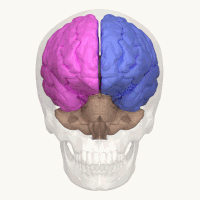
Photo from wikipedia
Abstract Prior investigations of selective attention using the Stroop task have indicated individuals with high levels of psychopathic traits show reduced Stroop interference only when there is spatial separation of… Click to show full abstract
Abstract Prior investigations of selective attention using the Stroop task have indicated individuals with high levels of psychopathic traits show reduced Stroop interference only when there is spatial separation of conflicting information. However, theories of psychopathy such as the left hemisphere activation hypothesis make specific predictions regarding the impact of rewards which have yet to be tested. Ninety-nine incarcerated male participants were assessed for psychopathy trait levels using the Psychopathy Checklist-Revised (PCL-R Hare, 1999) and completed four Stroop task variants, in which the spatial separation of conflicting information and the presence of financial reward/punishment contingencies varied. While the study failed to replicate previous findings of reduced interference on spatially separated Stroop tasks in individuals with high levels of psychopathy, the novel finding of reduced facilitation under reward conditions provides evidence corroborating the left hemisphere activation hypothesis of psychopathy.
Journal Title: Personality and Individual Differences
Year Published: 2018
Link to full text (if available)
Share on Social Media: Sign Up to like & get
recommendations!